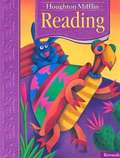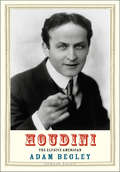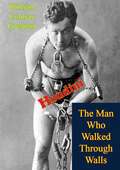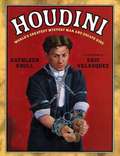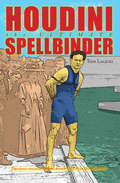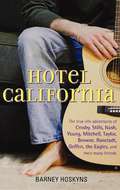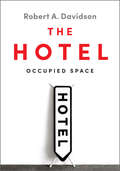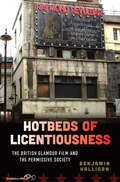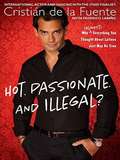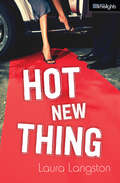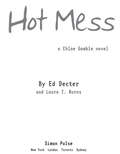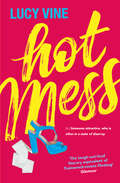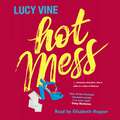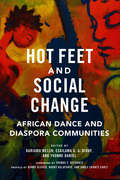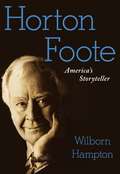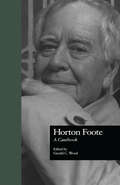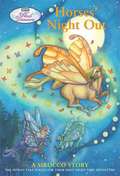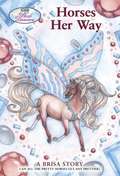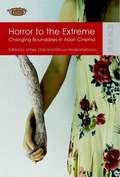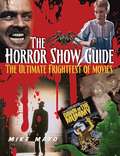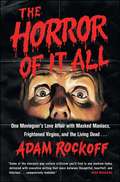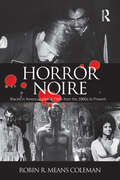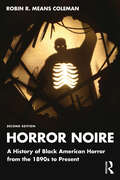- Table View
- List View
Houghton Mifflin Reading Rewards Level 3.1
by Houghton MifflinThe book contains: Theme 1: Off to Adventure!- Focus on Poetry; Theme 2: Celebrating Traditions-Focus on Trickster Tales; and Theme 3: Incredible Stories.
Houdini: The Elusive American (Jewish Lives)
by Adam BegleyFrom the prizewinning Jewish Lives series, an exuberant biography of the world&’s greatest escape artist In 1916, the war in Europe having prevented a tour abroad, Harry Houdini wrote a film treatment for a rollicking motion picture. Though the movie was never made, its title, &“The Marvelous Adventures of Houdini: The Justly Celebrated Elusive American,&” provides a succinct summary of the Master Mystifier&’s life. Born Erik Weisz in Budapest in 1874, Houdini grew up an impoverished Jewish immigrant in the Midwest and became world-famous thanks to talent, industry, and ferocious determination. He concealed as a matter of temperament and professional ethics the secrets of his sensational success. Nobody knows how Houdini performed some of his dazzling, death-defying tricks, and nobody knows, finally, why he felt compelled to punish and imprison himself over and over again. Must a self-liberator also be a self-torturer? Tracking the restless Houdini&’s wide-ranging exploits, acclaimed biographer Adam Begley asks the essential question: What kind of man was this?About Jewish Lives: Jewish Lives is a prizewinning series of interpretative biography designed to explore the many facets of Jewish identity. Individual volumes illuminate the imprint of Jewish figures upon literature, religion, philosophy, politics, cultural and economic life, and the arts and sciences. Subjects are paired with authors to elicit lively, deeply informed books that explore the range and depth of the Jewish experience from antiquity to the present. In 2014, the Jewish Book Council named Jewish Lives the winner of its Jewish Book of the Year Award, the first series ever to receive this award.More praise for Jewish Lives: &“Excellent.&” – New York times &“Exemplary.&” – Wall St. Journal &“Distinguished.&” – New Yorker &“Superb.&” – The Guardian
Houdini: The Man Who Walked Through Walls
by William Lindsay GreshamFirst published in 1959, this is a fascinating look at the life and career of magician and escape-artist Harry Houdini (1874-1926). Author William Gresham interviewed many people who knew Houdini personally, adding greatly to the book's accuracy and authoritativeness, and he also reviewed all of the available books, and newspaper and magazine articles on the magician. Gresham explains many of Houdini's illusions, and debunks some of the many myths surrounding the performer. Houdini's interest in the supernatural is examined, as are his efforts to expose the many fraudulent mediums and spiritualists of the time. Included are 8 pages of photographs.
Houdini: World's Greatest Mystery Man And Escape King
by Kathleen Krull Eric VelasquezIntroducing the astonishing, the unforgettable ... HOUDINI! He made himself a living legend and became the most famous name in magic. But Harry Houdini, like his acts, was fascinating and mysterious. As a child, he was often on the edge of homelessness, so he would charge crowds to watch him perform tricks he knew no one else could do. After leaving home to seek his fortune, Houdini mastered every form of magic available-- card tricks, juggling, illusions-- and travelled the world over to make a name for himself. But true stardom came to him only when he began to focus his act around daring, heart-stopping escapes. By sheer force of will, Houdini trained his body to withstand the torturous demands of the elaborate acts he created. How did he do it? Magicians never tell. Yet acclaimed author Kathleen Krull and award-winning illustrator Eric Velasquez combine their talents to reveal the remarkable story of the World's Greatest Mystery Man and Escape King.
Houdini: The Ultimate Spellbinder
by Tom LalickiOriginally published as: SPELLBINDER: The Life of Harry Houdini.He was born Ehrich Weiss but, at an early age, he chose another name for himself. He wanted a name to suit his career of magic and entertainment and he chose a name that paid homage to one of the legendary magicians of all time: Robert Houdin. His illusions and escapes were more astonishing and more challenging than anyone had ever done before and he eclipsed the names of all other magicians as his fame reached around the world, made him famous and made him the most famous illusionist ever.Houdini disappeared through brick walls. He escaped from straitjackets and then straitjackets immersed in water. He performed escapes in public places and from jail cells in major cities--and the crowds flocked to his performances.Tom Lalicki tells Houdini's story with a fascinating mix of text and images, revealing the facts and juxtaposing them with startling images of a master entertainer performing masterfully and mysteriously, mesmerizing his audiences and mystifying experts with his skill and his invention.
Hotel California: The True-Life Adventures Of Crosby, Stills, Nash, Young, Mitchell, Taylor, Brown, Ronstadt, Geffen, The Eagles, And Their Many Friends
by Barney HoskynsA look at the music scene in Los Angeles in the late 1960s and 1970s.
The Hotel: Occupied Space
by Robert A. Davidson<p>The Hotel: Occupied Space explores the hotel as both symbol and space through the concept of “occupancy.” By examining the various ways in which the hotel is manifested in art, photography, and film, this book offers a timely critique of a crucial modern space. <p>As a site of occupancy, the hotel has provided continued creative inspiration for artists from Monet and Hopper, to genre filmmakers like Hitchcock and Sofia Coppola. While the rich symbolic importance of the hotel means that the visual arts and cinema are especially fruitful, the hotel’s varied structural purposes, as well as its historical and political uses, also provide ample ground for new and timely discussion. In addition to inspiring painters, photographers, and filmmakers, the hotel has played an important role during wartime, and more recently as a site of accommodation for displaced people, whether they be detainees or refugees seeking sanctuary. Shedding light on the diverse ways that the hotel functions as a structure, Robert A. Davidson argues that the hotel is both a fundamental modern space and a constantly adaptable structure, dependent on the circumstances in which it appears and plays a part.</p>
Hotbeds of Licentiousness: The British Glamour Film and the Permissive Society
by Benjamin HalliganHotbeds of Licentiousness is the first substantial critical engagement with British pornography on film across the 1970s, including the “Summer of Love,” the rise and fall of the Permissive Society, the arrival of Margaret Thatcher, and beyond. By focusing on a series of colorful filmmakers whose work, while omnipresent during the 1970s, now remains critically ignored, author Benjamin Halligan discusses pornography in terms of lifestyle aspirations and opportunities which point to radical changes in British society. In this way, pornography is approached as a crucial optic with which to consider recent cultural and social history.
Hotbeds of Licentiousness: The British Glamour Film and the Permissive Society
by Benjamin HalliganHotbeds of Licentiousness is the first substantial critical engagement with British pornography on film across the 1970s, including the “Summer of Love,” the rise and fall of the Permissive Society, the arrival of Margaret Thatcher, and beyond. By focusing on a series of colorful filmmakers whose work, while omnipresent during the 1970s, now remains critically ignored, author Benjamin Halligan discusses pornography in terms of lifestyle aspirations and opportunities which point to radical changes in British society. In this way, pornography is approached as a crucial optic with which to consider recent cultural and social history.
Hot. Passionate. and Illegal?
by Cristian de la Fuente Federico LarinoFrom Dancing With the Stars finalist Cristian de la Fuente comes a tongue-in-cheek guide to understanding Latino culture-now in paperback. As a contestant on Dancing with the Stars, international star and actor Cristián de la Fuente automatically assumed the role of the flashy Latino dancer, donning bright fuchsia costumes with his bare chest exposed. But Cristián ultimately wowed the judges and reached the finals-not with his fancy footwork but with his charm. Quickly, the producers and viewers learned that just because someone is Latino does not necessarily mean he can dance... And Cristián proved Latinos can and should not be reduced to one-dimensional definitions. In Hot. Passionate. And Illegal?, Cristián uses his personal and funny experiences as a Latino in Hollywood to dispel common myths and admit the sometimes embarrassing, yet endearing, truths about Latinos.
Hot New Thing (Orca Limelights)
by Laura LangstonLily is discovered by a big-name director when she’s auditioning for a role in a toothpaste commercial. He wants her for his new movie, which is great except for the fact that it’s shooting in Los Angeles and Lily lives in Vancouver. With the help of her Chinese grandmother, she convinces her parents to let her go to LA with her agent as a chaperone. But when she gets there, she finds out that if she wants to be more than the flavor of the week, she’s going to have to pay a price that may be way too high.
Hot Mess (Chloe Gamble #3)
by Ed DecterThe final book in the rags-to-riches-to-rags trilogy that reads like an E! True Hollywood Story.
Hot Mess: The utterly hilarious and relatable Number One eBook bestseller
by Lucy VineThe eBook Number One bestseller The hottest book of the summer. A sassy, laugh out loud beach read everyone is talking about *****Hot Mess [n.] - someone attractive, who is often in disarray.Have you ever shown up to Sunday brunch still smelling of Saturday night?Chosen bed, Netflix and pizza over human contact?Stayed in your mould-ridden flat because it's cheap?Meet your spirit animal, Ellie Knight. Her life isn't turning out exactly as she planned. She hates her job, her friends are coupling up and settling down, and her flatmates are just plain weird.Some people might say she's a hot mess but who really has their sh*t together anyway? For fans of Fleabag and Girls, this is a fresh and funny coming-of-age story with a single-girl heroine that will speak to millennials everywhere.*****'The laugh-out-loud literary equivalent of Trainwreck-meets-Fleabag' Glamour'A breath of fresh air, deftly subverting some of chick lit's biggest clichés' Stylist'More lifestyle-affirming than Bridget Jones' Sarah Knight, author of The Life Changing Magic of Not Giving a F*ck'If you love dirty jokes, dating horror stories and hilarious dialogue, this book is for you' Emma Gannon, author and podcast host of Ctrl Alt Delete'I laughed and sighed with recognition as I turned every page' Daisy Buchanan, author of How To Be a Grown-Up
Hot Mess: Bridget Jones for a new generation
by Lucy VineHot Mess [n.] - someone attractive, who is often in disarray.Have you ever shown up to Sunday brunch still smelling of Saturday night?Chosen bed, Netflix and pizza over human contact?Stayed in your mould-ridden flat because it's cheap?Meet your spirit animal, Ellie Knight. Her life isn't turning out exactly as she planned. She hates her job, her friends are coupling up and settling down, and her flatmates are just plain weird.Some people might say she's a hot mess but who really has their sh*t together anyway? For fans of Fleabag and Girls, this is a fresh and funny coming-of-age story with a single-girl heroine that will speak to millennials everywhere.Everyone is talking about Hot Mess - the hilarious laugh-out-loud Bridget Jones for a new generation:'More lifestyle-affirming than Bridget Jones' Sarah Knight, author of The Life Changing Magic of Not Giving a F*ck'If you love dirty jokes, dating horror stories and hilarious dialogue, this book is for you' Emma Gannon, author and podcast host of Ctrl Alt Delete'I laughed and sighed with recognition as I turned every page' Daisy Buchanan, author of How To Be a Grown-UpRead by Elisabeth Hopper(p) Orion Publishing Group 2017
Hot Feet and Social Change: African Dance and Diaspora Communities
by Kariamu Welsh Esailama G. A. Diouf Yvonne DanielThe popularity and profile of African dance have exploded across the African diaspora in the last fifty years. Hot Feet and Social Change presents traditionalists, neo-traditionalists, and contemporary artists, teachers, and scholars telling some of the thousands of stories lived and learned by people in the field. Concentrating on eight major cities in the United States, the essays explode myths about African dance while demonstrating its power to awaken identity, self-worth, and community respect. These voices of experience share personal accounts of living African traditions, their first encounters with and ultimate embrace of dance, and what teaching African-based dance have meant to them and their communities. Throughout, the editors alert readers to established and ongoing research, and provide links to critical contributions by African and Caribbean dance experts.Contributors: Ausettua Amor Amenkum, Abby Carlozzo, Steven Cornelius, Yvonne Daniel, Charles “Chuck” Davis, Esailama G. A. Diouf, Indira Etwaroo, Habib Iddrisu, Julie B. Johnson, C. Kemal Nance, Halifu Osumare, Amaniyea Payne, William Serrano-Franklin, and Kariamu Welsh
Horton Foote
by Wilborn HamptonNo playwright in the history of the American theater has captured the soul of the nation more incisively than Horton Foote. From his Pulitzer Prize-winning play, The Young Man From Atlanta, to his film adaptation of To Kill a Mockingbird, which received an Oscar, millions of people have been touched by Foote's work. He has long been regarded by other playwrights and screenwriters, actors, and cognoscenti of the theater and cinema as America's master storyteller; critics compared him to William Faulkner and Anton Chekhov. Yet Horton Foote's compelling character and rich life remain largely unknown to the general public. His is the story of an artist who refused to compromise his talents for the sake of fame or money, or just to keep working -- who insisted on writing what he regarded as truth, even when for many years almost no one would listen. In the first comprehensive biography of this remarkable writer, Wilborn Hampton introduces Foote to countless Americans who have admired his work. Hampton, a theater critic for The New York Times, offers a colorful, compulsively readable account of a life and career that spanned seven decades. As a child in the small town of Wharton, Texas, Foote's favorite pastime was to listen to the stories his elders told -- about themselves, their families, their neighbors -- around the dinner table or sitting on the front porch. As he once explained: "One thing I was given in life is a deep desire to listen. I've spent my life listening. These stories have haunted me all my life." The stories also served as an inspiration for Foote's life work as he chronicled America's wistful odyssey through the twentieth century, mostly from the perspective of a small town in Texas. Beginning in the Golden Age of Television with dramas such as The Trip to Bountiful, through Broadway and Off-Broadway successes, to the mark he made in films such as Tender Mercies, and right up through a staging of his complete nine-play opus The Orphans' Home Cycle, he documented the struggle of ordinary people to maintain their dignity in the face of hardship and change that the erosion of time inevitably brings. It is a theme Horton Foote lived. Yet the paradox that shines through his work is that while the externals of life alter over the years -- wealth may be gained or squandered, love may be won or lost, friends and relations die -- people themselves do not. Like Eugene O'Neill, Arthur Miller, and Tennessee Williams, Horton Foote's portraits of American life are iconic and true. His stories have helped shape the way Americans see themselves -- indeed, they have become part of the nation's psyche, and they will speak to many generations to come.
Horton Foote: A Casebook (Casebooks on Modern Dramatists #24)
by Gerald C. WoodFirst Published in 1998. Routledge is an imprint of Taylor & Francis, an informa company.
Horses' Night Out (Wind Dancers, Book #4)
by Sibley MillerMeet the Wind Dancers® Four tiny horses with shiny manes and shimmering wings burst from a puff of dandelion seeds! Four magical horses who can fly. BOOK 4: Horses' Night Out What's it like to be out in the dark of night? The three magical fillies and the one colt, who is sure he's going to love the adventure, are about to find out.
Horses Her Way (Wind Dancers, Book #6)
by Sibley MillerBeautiful Brisa, with her sunset-pink coat and blonde mane and tail, happily sets out to make the world--and everything in it, including her fellow Wind Dancers--as lovely as she is. Sounds like a plan--that only one horse can love!
Horror to the Extreme
by Jinhee Choi Mitsuyo Wada-MarcianoThis book compares production and consumption of Asian horror cinemas in different national contexts and their multidirectional dialogues with Hollywood and neighboring Asian cultures. Individual essays highlight common themes including technology, digital media, adolescent audience sensibilities, transnational co-productions, pan-Asian marketing techniques, and variations on good vs. evil evident in many Asian horror films. Contributors include Kevin Heffernan, Adam Knee, Chi-Yun Shin, Chika Kinoshita, Robert Cagle, Emilie Yeh Yueh-yu, Neda Ng Hei-tung, Hyun-suk Seo, Kyung Hyun Kim, and Robert Hyland.
The Horror Show Guide
by Mike MayoFrom atomic bombs to zealous zombies, this cinefile's guidebook reviews 1,000 of the wickedest, weirdest, and wackiest scary movies from every age of horror. With reviews on many overlooked, underappreciated gems such as Alice Sweet Alice, Daughters of Darkness, and Zombie, as well as the numerous Stephen King adaptations and modern updates such as Night of the Living Dead 3D and The Wolfman, new devotees as well as the discriminating darkcinema enthusiast will love this big, beautiful, endall, beall guide to an always popular film genre. Established directors, including Wes Craven, John Carpenter, Tim Burton, David Cronenberg, and Guillermo del Toro are given their due, as are the new generation, represented by Larry Fessenden, James Wan, Alexandre Aja, and others. In addition to the hundreds of horror film reviews, this guide includes fascinating and fun top10 lists and sidebars that are designed to lead fans to similar titles they might not have known about.
The Horror of It All
by Adam RockoffPop culture history meets blood-soaked memoir as a horror film aficionado and screenwriter recalls a life spent watching blockbuster slasher films, cult classics, and everything in between. Horror films have simultaneously captivated and terrified audiences for generations, racking up billions of dollars at the box office and infusing our nightmares with unrelenting zombies, chainsaw-wielding madmen, and myriad incarnations of ghosts, ghouls, and the devil himself. Despite evolving modes of storytelling and the fluctuating popularity of other genres, horror endures. The Horror of It All is a memoir from the front lines of the industry that dissects (and occasionally defends) the hugely popular phenomenon of scary movies. Author Adam Rockoff traces the highs and lows of the horror genre through the lens of his own obsessive fandom, born in the aisles of his local video store and nurtured with a steady diet of cable trash. From Siskel and Ebert’s crusade against slasher films to horror’s Renaissance in the wake of Scream, Rockoff mines the rich history of the genre, braiding critical analysis with his own firsthand experiences. Be afraid. Be very afraid.
Horror Noire: Blacks in American Horror Films from the 1890s to Present
by Robin R Means ColemanFrom King Kong to Candyman, the boundary-pushing genre of the horror film has always been a site for provocative explorations of race in American popular culture. In Horror Noire: Blacks in American Horror Films from 1890's to Present, Robin R. Means Coleman traces the history of notable characterizations of blackness in horror cinema, and examines key levels of black participation on screen and behind the camera. She argues that horror offers a representational space for black people to challenge the more negative, or racist, images seen in other media outlets, and to portray greater diversity within the concept of blackness itself. Horror Noire presents a unique social history of blacks in America through changing images in horror films. Throughout the text, the reader is encouraged to unpack the genre’s racialized imagery, as well as the narratives that make up popular culture’s commentary on race. Offering a comprehensive chronological survey of the genre, this book addresses a full range of black horror films, including mainstream Hollywood fare, as well as art-house films, Blaxploitation films, direct-to-DVD films, and the emerging U.S./hip-hop culture-inspired Nigerian "Nollywood" Black horror films. Horror Noire is, thus, essential reading for anyone seeking to understand how fears and anxieties about race and race relations are made manifest, and often challenged, on the silver screen.
Horror Noire: A History of Black American Horror from the 1890s to Present
by Robin R. Means ColemanFrom King Kong to Candyman, the boundary-pushing genre of horror film has always been a site for provocative explorations of race in American popular culture. This book offers a comprehensive chronological survey of Black horror from the 1890s to present day. In this second edition, Robin R. Means Coleman expands upon the history of notable characterizations of Blackness in horror cinema, with new chapters spanning the 1960s, 2000s, and 2010s to the present, and examines key levels of Black participation on screen and behind the camera. The book addresses a full range of Black horror films, including mainstream Hollywood fare, art-house films, Blaxploitation films, and U.S. hip-hop culture-inspired Nollywood films. This new edition also explores the resurgence of the Black horror genre in the last decade, examining the success of Jordan Peele’s films Get Out (2017) and Us (2019), smaller independent films such as The House Invictus (2018), and Nia DaCosta’s sequel to Candyman (2021). Means Coleman argues that horror offers a unique representational space for Black people to challenge negative or racist portrayals, and to portray greater diversity within the concept of Blackness itself. This book is essential reading for anyone seeking to understand how fears and anxieties about race and race relations are made manifest, and often challenged, on the silver screen.
